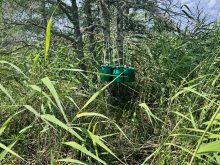The cold, snowy days of winter are the perfect time to plan a rotational grazing system, says Jim Stone.
The instructor at Olds College in Alberta uses an overhead projector and aerial photos of pastures to teach his students how to design these systems.
Producers who don’t have these tools should still plan to maximize their grazing areas, he said.
They can double the productivity of their grazing land by fencing these areas into paddocks and moving their cattle around, Stone said.
He uses a rotational system with his own 1,100 cattle.
Read Also

Research looks to control flea beetles with RNAi
A Vancouver agri-tech company wants to give canola growers another weapon in the never-ending battle against flea beetles.
“If they are moved every day you get the most advantage,” he said. “If I go to all my pastures it’s about 200 kilometres, so I set up a three-day rotation.”
Let fields rest
Ideally, cattle should not be returned to the first grazing area for 30 to 45 days to allow for proper growth, Stone said.
“Let’s say I want enough paddocks for a 36-day rotation,” he explained. “On a quarter of grass I could have 12 paddocks of about 12 acres each.”
The cattle would graze each paddock for three days and then be moved into the next one.
Rotations depend entirely on how many cattle and pastures a producer has and what the pasture can handle.
“The problem is we’re getting more and more cattle on the same land base,” he said. “Most of us have more cattle than we should have. We need to get more production out of our pastures.”
Stone also advocates fencing off creeks, hillsides, rivers and other areas and allowing selective access. He said if these areas are grazed properly they can be very productive.

















